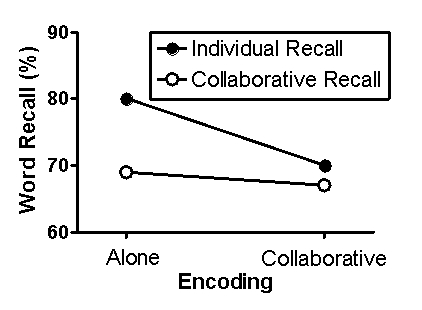Use the following to answer questions
Scenario I
Scenario I is based on and provides fabricated data consistent with the following study:
Barber,S.J. ,Rajaram,S. ,& Fox,E.B.(2012) .Learning and remembering with others: The key role of retrieval in shaping group recall and collective memory.Social Cognition,30(1) ,121-132.doi:10.1521/soco.2012.30.1.121
In a typical experiment on collaborative memory,participants first encode information individually and later attempt to recall the information either individually or in a small group (collaboratively) .While the recall of the collaborative group is better than that of any individual,the summed recall of individuals typically is better than the recall of the collaborative group.This is a phenomenon termed collaborative inhibition.Barber,Rajaram,and Fox (2012) investigated this phenomenon during both the encoding and retrieval stages of memory.
Participants created sentences out of a word bank,which provided for the opportunity to encode this information.After completing this task,participants engaged in an unrelated task-solving mazes-for 10 minutes.Then,in a surprise memory test,they were asked to recall as many words from the word bank as possible (retrieval) .
Participants were randomly assigned to one of four groups.In the first group (Alone-Alone) ,participants were studied individually during both the encoding and retrieval phases of the experiment.In the second group (Alone-Collaborative) ,participants were studied individually during the encoding phase and studied as part of a three-member team (triad) during the retrieval phase.In the third group (Collaborative-Alone) ,participants were studied in a triad during the encoding phase but individually during the retrieval phase.Finally,in the fourth group (Collaborative-Collaborative) ,participants completed both phases of the experiment as part of a triad.
Fabricated results illustrating the major finding of Barber et al.(2012) are presented in Figure 6.1.This figure shows the percentage of words from the word bank accurately recalled as a function of group.For the two groups that experienced the retrieval phase individually,scores represent the summed retrieval of the individuals comprising the group.For the two groups that experienced the retrieval phase as part of a triad,scores simply represent the collaborative performance.
Figure 6.1 
-(Scenario I) Which statement is TRUE?
Definitions:
Survivor Guilt
A psychological phenomenon where individuals feel guilty for surviving a traumatic event when others did not, questioning why they were spared.
Generalized Anxiety
A mental health disorder characterized by excessive and persistent worry about various aspects of life that is not focused on any one object or situation.
Antisocial Behavior
Actions that harm or lack consideration for the well-being of others, often violating social norms and laws.
Posttraumatic Stress Disorder
A psychological disorder that arises after exposure to or being part of a distressing event, leading to intense stress, recurring nightmares, and vivid flashbacks.
Q33: Which statement about implicit learning is TRUE?<br>A)Implicit
Q37: Memory misattribution may help explain experiences of
Q38: Mirror neurons in a monkey's brain do
Q60: Which item is a primary reinforcer?<br>A)good food
Q74: The strategies of highlighting material,rereading it,and summarizing
Q119: The enhanced ability to think about a
Q206: Any stimulus or event that decreases the
Q255: Checking your e-mail is reinforced with receiving
Q261: Short-term storage is to long-term storage as:<br>A)enhanced
Q269: Which statement is a CORRECT description of